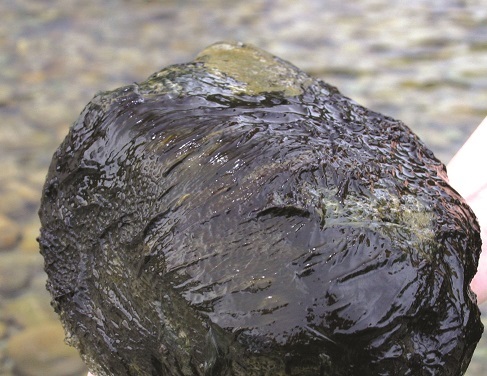Community urged to report toxic algae
Alexia Anderson
19 December 2023, 6:15 PM
 Benthic cyanobacteria is found in rivers and can be fatal, particularly to dogs. PHOTO: ORC
Benthic cyanobacteria is found in rivers and can be fatal, particularly to dogs. PHOTO: ORCIt is still unknown what caused the death of three dogs after visiting the Manuherekia River, off Galloway Rd, last weekend.
While the cause remains a mystery, Otago Regional Council scientist - water quality Helen Trotter said it could not completely rule out toxic algae being the culprit.
When asked by The Central App what other causes were likely, she said it was “unknown”.
“Because a very small amount of toxic algae is enough to cause serious illness (or death), it is difficult to completely rule this out as a possible cause, however no benthic cyanobacteria (toxic algae) has been recorded in the river at this site.”
She said Otago Regional Council (ORC) has limited information about the incident, so could not rule out the dogs had come into contact with toxic algae elsewhere, for example.
The dogs’ owners posted about the incident anonymously on Facebook.
The ORC said the “sad” incident was a reminder to be on the lookout for toxic algae in our waterways this summer.
ORC has done a thorough site assessment in the area, but found no sign of toxic algae at the site, or at popular access points downstream.
It was consistent with recent monitoring results at Shaky Bridge and Galloway, which have also not found potentially toxic algae to be present.
Helen said toxic algae are commonly found in and around waterways over summer, including the Manuherekia River and it was important people, dog owners in particular, were vigilant.
Just one teaspoon was enough to be fatal, so dogs should be kept on a leash to keep them away from the water and riverbank.
“Blooms frequently occur (most years) at Ophir in the Manuherekia River and we have a permanent warning sign at this site.”
She said other rivers throughout Otago, known to be cyanobacteria hotspots include Silver Stream (Mosgiel), Cardrona River (Central Otago), Hāwea River (Central Otago) and Waianakarua River (North Otago).
Helen encourages people to check the Land Air Water Aotearoa website before heading out, but anyone who had any doubts should stay out of the water.
She said it was also “very important” people contact ORC on its pollution hotline: 0800 800 033 if they discover what they think could be toxic algae and take a photo of it.
Blooms are more common during the summer months, when low rainfall, warm temperatures, the right level of nutrients and more sunlight create an environment where it can thrive.
“However in the right conditions toxic algae can bloom rapidly and just a teaspoon is enough to cause serious illness (or death), so people are urged to remain vigilant around our waterways this summer and if in doubt, stay out,” she said.
ORC follows the Ministry for the Environment guidelines in managing its response to potentially toxic algae.

Benthic cyanobacteria is a dark coloured matting of algae found on riverbeds, which can be washed up on rocks and banks. PHOTO: ORC
“We put up warning signs at popular access points when toxic algae reach levels that pose a risk to human and animal health.
However, not all sites with toxic algae will have warning signs because of the very large number of waterways across Otago, including many on private land, and because blooms can occur rapidly in the right conditions.
“It [is], therefore, really important for people to know how to spot toxic algae and if in doubt, stay out.
“We also use social media, our website and LAWA to help keep the public up to date on potential health risks.”
How to spot toxic algae:
• In rivers, look for dark brown mats like tar on the riverbed — mats can detach and wash up in the shallows and on banks.
• In lakes, look for murky green water like a pea soup.
Signs of poisoning include:
• Lethargy
• Muscle tremors
• Fast breathing
• Twitching
• Paralysis
• Convulsion
If you think your dog has eaten any toxic algae, see your vet immediately.
To find the latest toxic algae sightings visit the ORC’s website.

NEWS
JOBS







